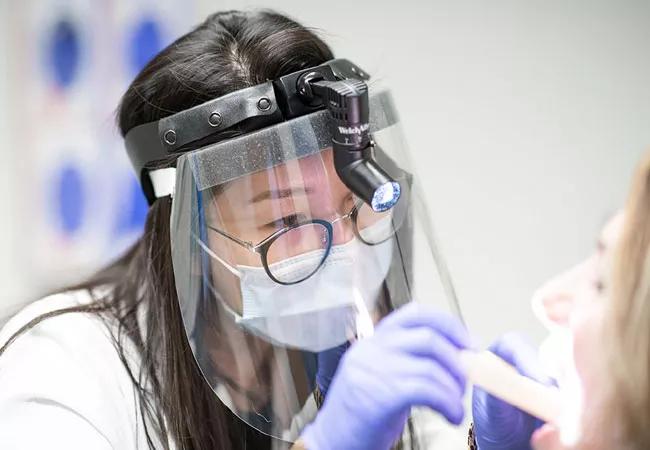Transoral robotic surgery enters a new era

Squamous cell carcinoma of the oropharynx is one of the only head and neck cancers still on the rise in the U.S. Once linked to tobacco and alcohol use, the disease today is more often attributed to human papillomavirus (HPV). Patients with HPV-related oropharyngeal (tonsils and tongue base) cancer tend to be younger and healthier nonsmokers, and have longer survivorship than patients with HPV-unrelated disease — making it even more important to minimize the long-term adverse effects of cancer therapy.
Advertisement
Cleveland Clinic is a non-profit academic medical center. Advertising on our site helps support our mission. We do not endorse non-Cleveland Clinic products or services. Policy
Transoral robotic surgery (TORS), which has become standard for oropharyngeal cancer (and some benign tumors) over the past decade, has helped deintensify cancer treatment. With proper selection, some patients have been able to reduce or avoid chemotherapy or radiation therapy.
In 2019, TORS entered a new era with innovative single-port technology, making the procedure even easier to control, more precise and thus more effective.
“We had been using the da Vinci SI® robotic system for TORS, which is a previous-generation multiport system with a rigid stereo-endoscope and two wristed instruments,” says Jamie Ku, MD, a surgeon in Cleveland Clinic’s Head and Neck Institute. “The new da Vinci SP® system is a single-port robotic surgical system specifically designed for head and neck surgery as well as urologic surgery.”
Cleveland Clinic is among the first medical centers in the U.S. to use the da Vinci SP system for head and neck procedures. It also was the first in the U.S. to use the system for urology procedures beginning in 2018.
“Tumors of the oropharynx traditionally were challenging to access and remove, and caused significant surgical morbidity,” says Dr. Ku.
Before TORS, removing oropharyngeal tumors — including those on the base of the tongue, palate and tonsil area — required an extensive open procedure. Surgeons would perform a mandibulotomy (splitting the lower lip and jaw bone) and make a large incision in the neck to access the back of the throat.
“These invasive surgeries increased not only patients’ recovery time and postop pain, but issues with chewing, swallowing and speech,” says Dr. Ku. “Patients would need a tracheostomy and a feeding tube following surgery. They’d be in the hospital for a minimum of one week.”
Advertisement
As such, many patients opted for radiation and chemotherapy instead of surgery. But those treatments also came with short-term and long-term adverse effects, including difficulty with swallowing, dry mouth, loss of taste, fibrosis, difficulty with mouth opening, and throat or neck swelling.
Things changed a little more than 10 years ago with the introduction of TORS. Advances in robotic technology and minimally invasive techniques made it possible to reach oropharyngeal tumors through the mouth. From a console, the surgeon views the surgical field in high-resolution 3D imaging relayed by an endoscope, and uses guided robotic arms and surgical tools to resect the tumor. Because TORS allowed easier access to an area difficult to reach with conventional tools, surgical time decreased from approximately four hours to one hour.
“The previous-generation da Vinci SI robotics system used three separate ports, which were a tight fit for a patient’s mouth and throat,” says Dr. Ku. “However, the newer da Vinci SP system has a single 2.5 cm port through which three fully articulating 6 mm instruments and a 1.2 cm stereo-endoscope camera are deployed. This system is ideally suited for minimally invasive surgery through the mouth.”
Better maneuverability ultimately means better visibility. And that’s important when making cuts around a tumor.
“We want just the right margins — no positive margins but no excessive margins — because the tissue we are removing is critical for swallowing and speech,” says Dr. Ku.
Advertisement
Research shows that swallowing and speech function after TORS is better than after conventional surgery. Recovery after TORS takes about three weeks, but with only one to three nights in the hospital. No tracheostomy is needed. About half of patients require a temporary nasogastric tube while the other half can manage a soft or liquid diet. The key to recovery is a multimodal pain regimen with aggressive oral hygiene, including humidification.
TORS also allows for accurate staging of the disease based on surgical pathology, which potentially can help minimize radiation and chemotherapy, or eliminate one or both altogether.
“Patient selection is the most important factor in treatment deintensification,” says Dr. Ku. “Patients who may benefit most from TORS include those with early stage tumors with limited lymph node involvement in the neck. Patients who smoke or have HPV-unrelated tumors are also candidates for surgical treatment because those oropharyngeal cancers may not respond as well to radiation and chemotherapy.”
Approximately 20-30% of patients with oropharyngeal tumors are ideal candidates for TORS.
“It takes a multidisciplinary team of head and neck cancer experts to determine the best, personalized treatment plan for each patient, which may or may not involve TORS or other treatments, including clinical trials,” says Dr. Ku.
Advertisement
Advertisement

Case study illustrates the potential of a dual-subspecialist approach

Evidence-based recommendations for balancing cancer control with quality of life

Study shows no negative impact for individuals with better contralateral ear performance

HNS device offers new solution for those struggling with CPAP

Patient with cerebral palsy undergoes life-saving tumor resection

Specialists are increasingly relying on otolaryngologists for evaluation and treatment of the complex condition

Detailed surgical process uncovers extensive middle ear damage causing severe pain and pressure.

Despite advancements in the specialty, patient-centered care needs to remain a priority